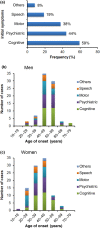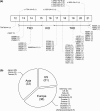Clinical and genetic characterization of adult-onset leukoencephalopathy with axonal spheroids and pigmented glia associated with CSF1R mutation
- PMID: 27680516
- PMCID: PMC5215554
- DOI: 10.1111/ene.13125
Clinical and genetic characterization of adult-onset leukoencephalopathy with axonal spheroids and pigmented glia associated with CSF1R mutation
Abstract
Background and purpose: The clinical characteristics of colony stimulating factor 1 receptor (CSF1R) related adult-onset leukoencephalopathy with axonal spheroids and pigmented glia (ALSP) have been only partially elucidated.
Methods: Clinical data from CSF1R mutation carriers who had been seen at our institutions or reported elsewhere were collected and analysed using a specific investigation sheet to standardize the data.
Results: In all, 122 cases from 90 families with CSF1R mutations were identified. The mean age of onset was 43 years (range 18-78 years), the mean age at death was 53 years (range 23-84 years) and the mean disease duration was 6.8 years (range 1-29 years). Women had a significantly younger age of onset than men (40 vs. 47 years, P = 0.0006, 95% confidence interval 3.158-11.177). There was an age-dependent penetrance that was significantly different between the sexes (P = 0.0013). Motor dysfunctions were the most frequent initial symptom in women whose diseases began in their 20s. Thinning of the corpus callosum, abnormal signalling in pyramidal tracts, diffusion-restricted lesions and calcifications in the white matter were characteristic imaging findings of ALSP. The calcifications were more frequently reported in our case series than in the literature (54% vs. 3%). Seventy-nine per cent of the mutations were located in the distal part of the tyrosine kinase domain of CSF1R (102 cases). There were no apparent phenotype-genotype correlations.
Conclusions: The characteristics of ALSP were clarified. The phenotype of ALSP caused by CSF1R mutations is affected by sex.
Keywords: adult-onset leukoencephalopathy with axonal spheroids and pigmented glia; colony stimulating factor 1 receptor; hereditary diffuse leukoencephalopathy with spheroids; leukoencephalopathy; pigmented orthochromatic leukodystrophy.
© 2016 The Authors. European Journal of Neurology published by John Wiley & Sons Ltd on behalf of European Academy of Neurology.
Figures



References
-
- Axelsson R, Röyttä M, Sourander P, Akesson HO, Andersen O. Hereditary diffuse leucoencephalopathy with spheroids. Acta Psychiatr Scand Suppl 1984; 314: 1–65. - PubMed
-
- Terada S, Ishizu H, Yokota O, et al An autopsy case of hereditary diffuse leukoencephalopathy with spheroids, clinically suspected of Alzheimer's disease. Acta Neuropathol 2004; 108: 538–545. - PubMed
-
- Baba Y, Ghetti B, Baker MC, et al Hereditary diffuse leukoencephalopathy with spheroids: clinical, pathologic and genetic studies of a new kindred. Acta Neuropathol 2006; 111: 300–311. - PubMed
MeSH terms
Substances
Grants and funding
LinkOut - more resources
Full Text Sources
Other Literature Sources
Research Materials
Miscellaneous

